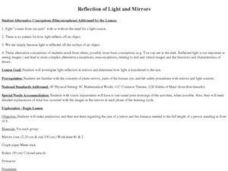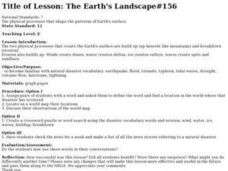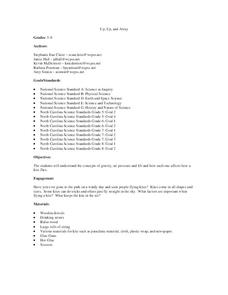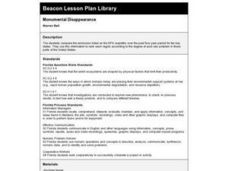Curated OER
Local Area - What Is a Region?
Students examine the physical characteristics of the Connecticut River Valley. They analyze maps and pictures, identify physical characteristics of the region, and color in the Connecticut River on a map.
Curated OER
Brine Shrimp Survival
Students develop an understanding of how growth and survival of an organism depends on physical conditions. They design an artificial environment in which brine shrimp can thrive. Students determine the optimum salinity for hatching of...
Curated OER
Pulse Rates
Students answer the question, "How will the intensity of exercise effect your heart rate?", using physical workouts and AppleWorks, or similar spreadsheet program. This lesson can conclude with the creation of a graph of data collected.
Curated OER
A FOREST'S PLACE IN OREGON
Students engage in a lesson to find the purpose for the forests of Oregon. The role of the forest is researched according to different geographic perspectives. The information is portrayed in graphs and presented by group members to...
Curated OER
Wh0-o-o-o's Out There?
Fifth graders describe the physical features of an owl and identify survival adaptations. They Investigate an owl's niche in an ecosystem. The students participate in an interactive puzzle on the internet that helps for motivation.
Curated OER
Come on In- the Water's Fine
Students examine how coastal erosion effects seaside communities. They investigate how people have to make choices when manipulate the physical environment such as when dredging and constructing seawalls in coastal areas. They complete a...
Curated OER
Jell-O Optics
Students observe an activity with Jell-O to learn about optics. For this investigative lesson students fill out a handout on the activity that helps them to investigate the index of refraction and the speed of light.
Curated OER
Lithography Techniques/Making a Printed Circuit Board
Students create an electronic schematic on their PCB. In this physics instructional activity, students solder and assemble electronic components. They research the function of these components and share their findings in a group.
Curated OER
Pipeline to the Coral Reefs
Students discuss the relationship of density to stratification. In this marine science lesson, students create a model of upwelling events using cold and warm water. They discuss how water phenomena affect coral reefs.
Curated OER
Make a Rain Stick
Young scholars create a rain stick to imitate the nature sounds in a rainforest habitat. In this rainforest habitat lesson, students create a rain stick to mimic the cultural tools used in the South American rainforest. Young scholars...
Curated OER
Solids, Liquids and Gases
Students are introduced to the various states of matter. After watching a video, they discover how to compare the three states using its shape and volume. In groups, they participate in an experiment with solids, liquids and gases and...
Curated OER
The Change of a River
Students explore changes in the Missouri River. In this Missouri River activity, students discover that changes in the atmosphere cause changes in the river. Students search the Internet for information about the Missouri River and its...
Curated OER
Extra! Extra!
Students describe how plants and animals depend on each other. They see how living and nonliving environments change over time. They identify ways in which humans have changed their environment and the effects of those changes.
Curated OER
Introduction to Friction
Students study the properties of the frictional force between two surfaces in contact. They inspect various phenomena in nature where friction plays an important role and demonstrate
Curated OER
Reflection of Light and Mirrors
Students address common misconceptions concerning reflection, light and mirrors. They investigate light reflection in mirrors and determine how light is transferred to the eye. In addition, they make predictions and then test them...
Curated OER
Shapes (Orienteering)
Students explore the tools of navigation. In this shapes lesson, students navigate using direction cues to create a shape. Students follow specific steps to create their shapes. Students use compasses to see the directions they are...
Curated OER
The Earth's Landscape#156
Students define a word from the natural disaster list, find a location in the world where this type of disaster has occurred and discuss what they have identified. They design a crossword puzzle of natural disaster words or check a...
Curated OER
Body and Blood
Students explore the cardiovascular system. Through the use of video, students observe the heart pumping an oxygen-enriched blood supply through arteries to the muscles in use during exercise. They participate in activities to explore...
Curated OER
Gene Puzzles
Young scholars come to understand that in sexually reproducing organisms, such as humans, typically half of the genes come from each parent.
Students examine a fictional pedigree and determine which gene is responsible for a given trait....
Curated OER
Up, Up and Away
Tenth graders experiment with gravity and air pressure. In this geometry lesson, 10th graders build their own kits and fly it. They investigate the questions: what keeps a kite in the air and what are some important factors when flying a...
Curated OER
Blast Off with Model Rockets
Students investigate science and math by building a rocket. In this geometry activity, students build a rocket using paper towel tubes while investigating questions about launching a rocket. They discuss balance and unique structure as...
Curated OER
Enzymatic Action
Students observe how a cell uses an enzyme to rid itself of a poisonous substance by experimenting with hydrogen peroxide, potatoes, liver and carrots. They record the temperature and changes of the hydrogen peroxide as other elements...
Curated OER
Monumental Disappearance
Fourth graders compare the emissions listed on the EPA isopleths over the past five-year period for ten key states. They use this information to rank each region according to the degree of acid rain problem in those parts of the United...
Curated OER
Nomad Land
Learners explore the migratory movements of animals as they monitor their own movements throughout the school day. Climatic and feeding conditions are examined as cues for the movement.

























